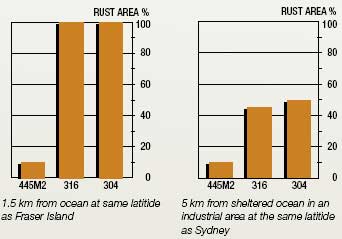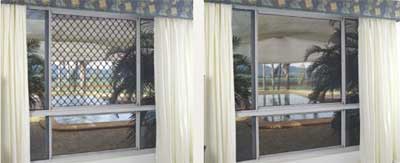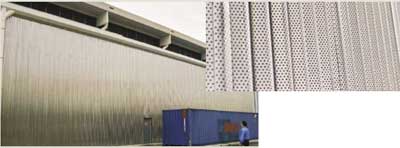|
Marine grade stainless steel 316 has been around for a long time. Now there’s an alternative, that’s even better – grade 445M2 from Austral Wright Metals. Developed in Japan, with a successful track record in Australasia, 445M2 offers real advantages over 316.
How Does 445M2 Stainless Steel Differ from 316 Stainless Steel
Unlike 316, 445M2 has a ferritic microstructure, and a higher content of the corrosion resisting element, chromium.
Benefits of 445M2 Stainless Steel over 316 Stainless Steel
That gives grade 445M2 some big technical benefits over grade 316 such as:
- Better resistance to atmospheric corrosion & pitting corrosion in water containing chlorides
- Not subject to stress corrosion cracking, or intergranular corrosion when welded properly
- Much better working characteristics – much easier to cut, bend and fold
- Better thermal properties, giving less distortion in welding and requiring less tack welding
- Lower density, covering 3.5% more area at the same weight
Fabrication of 445M2 Stainless Steel Compared to 316 Stainless Steel
Grade 445M2 has excellent punchability, bendability and weldability, making it easy to fabricate. It fabricates like carbon steel, without the strong work hardening of austenitic stainless steels like 316, which make them hard to cut and bend.
445M2 Stainless Steel
Applications of 445M2 Stainless Steel
Typical applications of grade 445M2 are anywhere that 316 is used now.
Grade 445M2 is ideal for:
- Kitchen benchwork
- Food preparation equipment
- Street furniture
- Heat exchangers
- Solar panels
- Roofing
- Walling
- Rainwater goods
In fact, anywhere that 316 is used for its corrosion resistance, 445M2 will perform better.
Availability of 445M2 Stainless Steel
Marine grade 445M2 is available as coil and sheet 1219 mm wide and 0.55, 0.7, 0.9, 1.2, 1.5, 1.6, 2.0, 2.5 and 3.0 mm thick – all 1219 mm wide. Ask us if you need narrower material. The standard finish is 2B, ask about the non-reflective 2DR finish if you want a lower gloss level for architectural applications.
Fabrication Using 445M2 Stainless Steel
Grade 445M2 is easier to work with than austenitic stainless steels such as 316: the much lower rate of work hardening gives lower forming loads and less springback. Grade 445M2 also behaves like carbon steel in cutting operations: it gives cleaner cuts, with less distortion, and much better tool life.
These advantages have been crucial for the introduction of the grade to uses like roll formed roofing and cladding and expanded metal. It is also very useful for perforating into acoustic screens etc.
Weldability of 445M2 Stainless Steel
- 445M2 can be spot or seam resistance welded. Post heat treatment of the weld is not required.
- 445M2 can be TIG or MIG welded. Pre or post-heating or post-weld heat treatment is not required.
- 445M2 can be welded without filler metal. If filler metal is required, use 316L(Si)
- 445M2 can be laser or plasma cut
After welding, the full corrosion resistance of the surface can be restored by removing any scale and oxide colors mechanically or chemically. Best corrosion resistance is achieved by pickling to ensure the removal of the low chromium layer formed under the high-temperature oxide during welding.
Pickling pastes are available: in common with other highly corrosion resistant grades, 445M2 should usually be pickled for a time towards the top of the recommended period.
Corrosion Resistance of 445M2 Stainless Steel
The world class Japanese steel mill, Nisshin Stainless Steel have formulated this grade carefully for good properties. The extra high chromium content (22%) and added molybdenum give excellent corrosion resistance. Then there’s a well balanced addition of small amounts of both niobium and titanium to protect the properties when the steel is welded.
And all heats of 445M2 are made with very low carbon content, well below the 0.03% carbon in the special low carbon 316L used for better-welded corrosion resistance.
Corrosion Scientists use PREN (Pitting Resistance Equivalent Number) to compare the resistance of different grades to localized corrosion. With a typical PREN of 26, 445M2 has better corrosion resistance than 316 with a typical PREN of 25.

Figure 1. Pitting corrosion resistance of stainless steel 445M2 compared to 316 and 305 stainless sheets of steel.
Properties of 445M2 Stainless Steel
Chemical Composition of 445M2 Stainless Steel
Table 1. The chemical composition of 445M2 stainless steel compared to 316 stainless steel.
|
|
|
445M2
|
22.1%
|
1.2%
|
0.01%
|
-
|
Nb and Ti
|
|
316
|
18.2%
|
2.2%
|
0.5%
|
10%
|
-
|
Typical Mechanical and Physical Properties of 445M2 Stainless Steel
Table 2. The chemical composition of 445M2 stainless steel compared to 316 stainless steel.
|
|
|
Density
|
kg/m3
|
7750
|
7980
|
|
Yield stress
|
MPa
|
350
|
315
|
|
Tensile strength
|
MPa
|
520
|
560
|
|
Youngs Modulus
|
MPa
|
199000
|
193000
|
|
Elongation
|
%
|
30
|
55
|
|
Hardness
|
Hv
|
170
|
155
|
|
Thermal Conductivity
|
W/m.°C
|
22.5
|
13.9
|
|
Thermal Expansion
|
x10-6°C
|
10.0
|
16.0
|
|
Magnetism
|
-
|
Magnetic
|
Non-Magnetic
|
445M2 Stainless Steel Case Studies
Stainless Steel Security Screens
Austral Wright Metals worked closely with the Lockers Group to develop expanded metal mesh for security doors and windows. The existing aluminum mesh gave excellent performance inland but had limited life in the aggressive conditions near the ocean. Lockers turned to stainless steel for a solution.

Figure 2. A traditional security screen on the left and the 445M2 stainless steel alternative on the right.
But flat panels of mesh were hard to produce in 316, and the tools wore rapidly, causing high downtime for tool sharpening. 445M2 solved both problems and had even better corrosion resistance to cope with the arduous conditions near the ocean.
Manufacturing Director Peter Lowther says “the strong sales growth of the marine grade stainless steel security mesh testifies to the suitability of 445M2 for this application. We provide a superior product for our customers, which uses the strength of the 445M2 to give an unobstructed view from comfort and security. The boys in the tool room love it - they don’t see the tools as often as they used to!”
Stainless Steel Walling, Roofing, Guttering and Downpipes
Glen Roberts, Market Development Manager at Stramit, says “We supply walling, roofing, gutters and downpipes in 445M2. We haven’t had a problem with tea staining, and we have minimal setup time when we run 445M2 on roll formers set up for carbon steel – cleanliness is the key. We always clean the machines down well to remove any carbon steel contamination.

Figure 3. 445M2 walling and an exploded view of the perforated stainless steel acoustic panel on the right.
We have even had success perforating 445M2 for acoustic screens. When combined with enclosed 50mm acoustic glass wool, Stramit® Acoustic Panels are an effective noise-reduction solution for gymnasiums, factories, public buildings and offices. The wall and ceiling panels add value by providing a “three-in-one” solution that acts as cladding, sound barrier, and thermal insulation simultaneously.”
Summary of 445M2 Stainless Steel
|
1. Features
|
445M2 is a generation of ferritic stainless steel with better corrosion resistance than 316. It has been used in roofing and facades of buildings, hot water applications, and wherever high resistance to corrosion and staining is needed.
|
|
2. Chemical Composition
|
445M2 contains 22% chromium and 1.2% molybdenum, which gives it outstanding corrosion resistance. It does not contain a nickel addition.
|
|
3. Microstructure
|
445M2 is supplied in the annealed condition, with a clean, equiaxed microstructure.
|
|
4. Physical Properties
|
445M2 gives 3.5% more area per kg than an austenitic grade like 316. It also has lower thermal expansion and higher thermal conductivity so distorts less in welding.
|
|
5. Mechanical Properties
|
The yield strength and hardness of 445M2 are higher than 316. The tensile strength and elongation are lower.
|
|
6. Formability
|
The work hardening coefficient of 445M2 is much lower than 316. It forms in a similar way to carbon steel, and the lower spring back and easier shearing give better performance in tools and equipment designed for carbon steel.
|
|
7. Corrosion Resistance
|
|
|
7.1 Pitting Corrosion
|
Electrochemical tests in chloride solutions show 445M2 resists pitting corrosion better than 316.
|
|
7.2 Crevice Corrosion
|
Electrochemical tests in chloride solution show 445M2 resist crevice corrosion better than 316 in the as-supplied condition. It is far superior after spot welding.
|
|
7.3 Intergranular Corrosion
|
Very low carbon content and stabilization with niobium and titanium give 445M2 excellent resistance to intergranular corrosion after sensitizing thermal cycles, superior to 316.
|
|
7.4 Stress Corrosion Cracking
|
445M2 is substantially immune from stress corrosion cracking in chloride-containing waters, unlike grade 316.
|
|
7.5 Rust Resistance
|
|
|
7.5.1 Rooftop
|
In tests simulating an exposed roof in a marine environment, where frequent rain would wash away salt, there was minimal rust staining on 445M2 – much less than 316.
|
|
7.5.2 Eaves
|
Tests simulating an even more severe marine environment – a sheltered area, where salt concentrates – showed minimal rust on 445M2 – much less than 316 which was badly stained.
|
|
7.5.3 Atmospheric exposure tests
|
In atmospheric exposure tests in a severe marine sub-tropical area (equivalent to Fraser Island) 445M2 was almost completely free of rusting (or tea staining) after 2 years of exposure. 316 was uniformly tea stained.
|
|
7.6 General Corrosion (Acid Resistance)
|
Sulphuric acid is very aggressive to stainless steels, as it interferes with the formation of the passive surface film. 445M2 has about 1/5 the corrosion rate of 316 in low concentrations of sulphuric acid at elevated temperatures.
|
|
8. Weldability
|
|
|
8.1 TIG & MIG Weldability
|
445M2 is easily weldable by TIG or MIG. The steel should be degreased, well-shielded with argon and the heat input kept low. 316L(Si) consumables are used.
|
|
8.2 Spot & Seam Weldability
|
445M2 is easily weldable by spot & seam welding.
|
|